"فقط افعلها."
في عام 1988، صاغت وكالة إعلانية حديثة النشأة هذا الشعار لأول عميل لها، وهي شركة ملابس رياضية صغيرة من ولاية أوريغون تدعى نايكي. المفاجأة المفاجأة: إن حملة تسويقية حققت نجاحًا فوريًا.
العبارة جذابة بالتأكيد، ولكن هذا ليس السبب الوحيد وراء نجاح الحملة الإعلانية. فقد أحسنت الوكالة أيضًا في توقيتها.
من الواضح أن إدارة الحملات التسويقية مهمة، لكنها قد تبدو شاقة بالنسبة للوكالات. كيف توازن بين الحملات بين العملاء؟ كيف تحافظ على السيطرة على الحملات دون أن تكون داخل الشركة؟
لا تتعب نفسك!
في هذا الدليل لإدارة الحملات التسويقية، سنغطي كل ما تحتاج إلى معرفته لتنفيذ حملات ناجحة لعملائك من البداية إلى النهاية.
ما هي إدارة الحملات التسويقية؟
إدارة الحملات التسويقية هي عملية تخطيط وتنفيذ ومراقبة جهود التسويق الاستراتيجي. وهي تشمل جميع المهام اللازمة لتنظيم حملة تسويقية وإطلاقها وتقييمها على مدار دورة حياتها بالكامل، بدءًا من الاستراتيجية إلى الانطلاق إلى ما بعد الوفاة .
إذا كنت تتعامل مع إدارة الحملات التسويقية للعملاء في وكالة ما، فمن المحتمل أن تكون مسؤولاً عن أمور مثل
- تحديداستراتيجية التسويق
- إجراء أبحاث السوق لمعرفة الجمهور المستهدف
- مساعدة العملاء على تحديد وإدارة ميزانية التسويق الخاصة بهم
- إنشاء وإدارة تقويم المحتوى
- تعزيز التعرف على العلامة التجارية لعملائك من خلال المحتوى والتسويق عبر وسائل التواصل الاجتماعي
- إنشاء رسومات ومقاطع فيديو مذهلة بصريًا تنقل رسائل عملائك للإعلانات /%img/ https://clickup.com/blog/wp-content/uploads/2022/07/ClickUp-Goals-Feature-CTA-V4.png ClickUp Goals ميزة الأهداف CTA المدونة /%img/ ### العناصر الرئيسية تخطيط إدارة الحملات التسويقية
كجزء من إدارة المشاريع التسويقية ، تحتاج إلى تحديد جميع المكونات التي تحتاجها الحملة التسويقية لعملائك لتحقيق النجاح.
إليك ستة عناصر رئيسية يجب التركيز عليها عند التخطيط للحملات التسويقية للعملاء
- الجمهور: لمن تقوم بالتسويق؟ سيحدد جمهور عميلك المستهدف الرسائل التي ستلقى صدى، والقنوات التي ستوجهها إلىالوصول إلى هذا الجمهوروتنسيقات المحتوى التي يستخدمها الجمهور المستهدف أكثر من غيرها.
- أهداف التسويق و OKRs: لماذا تدير حملة تسويقية؟ الأهداف الواضحة تجعل فريقك مسؤولاً أثناء عمله على مشاريع العملاء. ومع وجود مقاييس محددة بشكل جيد للنتائج، يكون لديك طريقة لتتبع تقدم فريقك نحو تلك الأهداف. تُبقي هذه المقاييس كلاً من فريقك وعملائك على علم بما تقوم به، ولماذا تقوم به، ومدى فعالية جهودك.
- الميزانية: تضع ميزانية الحملة التسويقية لعميلك حدًا محددًا للمبلغ الذي يمكنك أنت أو عميلك إنفاقه على هذه المبادرة المحددة. وفي حين أنك لا ترغب في أن تسحق ميزانيات العملاء الإبداع، استخدم المبلغ لقياس ما إذا كانت أفكار فريقك للحملة قابلة للتنفيذ.
- الأنشطة التسويقية: ما نوع الحملة التي ستنشئها لعميلك؟ هذا السؤال هو المفتاح لمعرفةتخصيص المواردالمتوقعالمنجزاتوالجداول الزمنية في المستقبل. سيتطلب الإعلان التلفزيوني موارد أكثر بكثير من حملة رسائل إخبارية عبر البريد الإلكتروني. سيعتمد نوع الحملة التسويقية التي تديرها أيضًا على القنوات التي تستخدمها للوصول إلى الجمهور المستهدف لعميلك. على سبيل المثال، إذا كنت تريدالتحدث إلى الجيل Zفإن حملات التسويق عبر وسائل التواصل الاجتماعي على منصات الفيديو القصيرة مثل TikTok هي الطريقة المثلى.
- الجدول الزمني: ما هي المدة التي ستستغرقها حملة عميلك في التخطيط والتنفيذ، و متى ستكون رسالتك أكثر فعالية؟ حدّد تاريخ بدء حملتك وتاريخ انتهائها، وخطط للمعالم المناسبة علىالجدول الزمني. إذا كنت تعلن عن حملة تنزيلات العودة إلى المدرسة في الولايات المتحدة، فغالبًا ما سترغب في تشغيل الحملة من أواخر يوليو إلى منتصف أغسطس. يجب أن يبدأ التخطيط في موعد أقصاه شهر يونيو، على أن يتم الانتهاء من جميع المخرجات بحلول منتصف يوليو، وستقوم بتقييم نتائج الحملة في شهر سبتمبر.
- الفريق: مثل فريق المنتقمون، ستحتاج إلى تجميع فريق الأحلام من المساهمين في وكالتك (كتّاب الإعلانات والمصممين وما شابه ذلك) الذين يمكنهم التعامل مع كل مهمة في قائمة مهام حملتك التسويقية. ضع في الحسبان مجموعات مهارات أعضاء الفريق وتوافرهم عند اختيار مجموعتك.
المكافأة:_ برامج إدارة العلامات التجارية
7 خطوات لإدارة الحملات التسويقية عالية التأثير ## 7 خطوات لإدارة الحملات التسويقية عالية التأثير
لإظهار كيفية عمل إدارة الحملات التسويقية عمليًا، دعنا نتخيل أنك مدير تسويق في وسائل التواصل الاجتماعي وكالة تسويق. عميلك هو شركة MySkinDoc، وهي شركة ناشئة متنامية؛ ومنتجها عبارة عن تطبيق للرعاية الصحية عن بُعد يربط أطباء الجلدية المرخصين عن بُعد بالمرضى. قام العميل بتعيينك لإدارة حملة على وسائل التواصل الاجتماعي (نأمل أن تكون سريعة الانتشار) رفع مستوى الوعي بعلامتهم التجارية .
دعنا نقسم استراتيجية إدارة حملتك التسويقية إلى سبع خطوات قابلة للتنفيذ.
1. افهم جمهورك المستهدف 🙋
يعتمد نجاح الحملة التسويقية على مدى نجاحها مع الجمهور المستهدف للعلامة التجارية. وبصفتك وكالة، عليك أن تتعمق في البحث عن العملاء الرئيسيين لعميلك قبل الغوص في إنشاء الحملة.
اطرح هذه الأسئلة للدخول إلى عقول الجمهور المستهدف والتسويق لهم بشكل أكثر فعالية:
- من أكثر المستفيدين من منتج أو خدمة عميلك؟
- ما هي رغبات الجمهور المستهدف واهتماماته وسلوكياته؟
- ما هي نقاط الألم التي يعاني منها الجمهور، وكيف يمكن لعميلك حلها؟
- أين يقع المتلقي المستهدف من هذه الحملة في مسار التسويق: هل هو في قمة (الوعي)، أم في الوسط (التفكير)، أم في الأسفل (الشراء)؟
للإجابة على هذه الأسئلة، ستحتاج أنت وفريقك على الأرجح إلى إجراء بعض أبحاث السوق وتقسيم الجمهور. اسأل العميل عما إذا كان لديه أي شخصيات المشترين أو ملفات تعريف العملاء المثالية يمكنهم مشاركتها لاستكمال هذا البحث.
تساعدك استطلاعات العملاء من العميل أيضًا على فهم جمهوره المستهدف واحتياجاته، مما يساعدك في عملية إدارة حملتك التسويقية.
أمثلة على الإجابات: الأشخاص الذين سيشتركون في MySkinDoc:
- هم الأفراد الذين يعانون من مشاكل جلدية ولا يستطيعون أو لا يرغبون في زيارة طبيب الأمراض الجلدية شخصيًا
- يرغبون في الحصول على بشرة صافية وصحية ويستخدمون وسائل التواصل الاجتماعي لمتابعة العلامات التجارية ذات الصلة باهتماماتهم
- ربما يشعرون بالوعي الذاتي بشأن مظهرهم وغير متأكدين من خياراتهم خارج نطاق زيارة الطبيب شخصيًا؛ يمكن ل MySkinDoc أن يربطهم بطبيب الأمراض الجلدية عن بُعد، دون إصدار أحكام
- لا يزالون في قمة اهتماماتهم في هذه المرحلة ويصبحون على دراية بماي سكيندوك؛ فأنت تريدهم أن يختاروا البقاء على اتصال مع عميلك من خلال الضغط على زر "متابعة"
2. وضع أهداف محددة وأنواع الحملات 🎯
ما الذي يرغب العميل في تحقيقه من خلال هذه الحملة، وما نوع الحملة التي تناسب هذا الهدف على أفضل وجه؟
عادةً ما يكون لدى العملاء فكرة عامة عن أهدافهم وما يعتقدون أن الحملة يجب أن تبدو عليه. وتتمثل مهمتك في أن تكون محددًا حتى لا تكون هناك مفاجآت حول ما يتم تقديمه. ضع في اعتبارك هذه القائمة من أهداف الحملات التسويقية المحتملة وأنواع الحملات التسويقية:
- زيادة عدد الاشتراكات التجريبية المجانية: تشغيل إعلانات مدفوعة على وسائل التواصل الاجتماعي تستهدف العملاء المحتملين على لينكد إن وتويتر
- نجاحإطلاق منتج جديد ميزة: إنشاء صفحات مقصودة جديدة ومثيرة ومسودة بيانات صحفية للنشر على هاكر نيوز
- دفع المبيعات: قم بتشغيل حملة تسويق عبر البريد الإلكتروني لتذكير الأشخاص بعرباتهم المتروكة في غضون 24 ساعة من مغادرة موقعك الإلكتروني
- زيادة عدد زيارات الموقع الإلكتروني وتحسين الوصول العضوي: إنشاء سلسلة من قوائم تحسين محركات البحث التي تحتل المرتبة الأولى في الصفحة رقم 1 من نتائج محرك البحث بحلول نهاية العام مع قوائم "أفضل منتج/برنامج/ أداة".
مثال: لنعد إلى مثال MySkinDoc. إنه منتج جديد إلى حد ما، لذا يرغب فريق الشركة في زيادة الوعي بالعلامة التجارية من خلال سلسلة من الإعلانات المدفوعة على تويتر وإنستجرام وتيك توك. أنت تخطط لجذب انتباه مستخدمي وسائل التواصل الاجتماعي من خلال عرض صور ومقاطع فيديو "قبل" و "بعد" من مستخدمي MySkinDoc الحقيقيين.
3. إنشاء مقاييس لقياس النجاح 🔢
بمجرد أن تعرف ما يجب أن تحققه الحملة التسويقية لعميلك، يمكنك بعد ذلك تحديد كيفية تقييم فعالية الحملة. مؤشرات الأداء الرئيسية للتسويق يجب أن تكون مرتبطة مباشرةً بمدى نجاح الحملة التسويقية في تحقيق أهداف العميل التي حددتها في الخطوة 2.

اجمع كل أعمالك معًا في نظرة عامة عالية المستوى باستخدام لوحات المعلومات
فيما يلي بعض الأمثلة على مقاييس التسويق التي يمكنك استخدامها لقياس النجاح بناءً على أهداف عميلك:
- لإطلاق منتجات جديدة وتوليد الإيرادات: معدلات التحويل، ومعدلات النقر على البريد الإلكتروني، والعملاء المحتملين المؤهلين، والاشتراكات الجديدة، وعمليات البيع، والعائد على الاستثمار
- لزيادة عدد الزيارات: تصنيفات الكلمات المفتاحية، وسلطة المجال، وحركة البحث العضوية، وإجمالي عدد زيارات الصفحات، وزوار الصفحة الفريدين، ومعدل الارتداد، وتكلفة حملات الدفع مقابل النقرة
- للتوعية بالعلامة التجارية: مشاعر المستخدمين، ومقاييس التفاعل على وسائل التواصل الاجتماعي، والمشاهدات على يوتيوب، والإشارات على وسائل التواصل الاجتماعي أو في الصحافة، وحجم البحث عن الكلمات الرئيسية ذات العلامة التجارية
- بالنسبة للفعاليات: إجمالي الاشتراكات أو مبيعات التذاكر، وإجمالي الحضور، والعملاء المحتملين المؤهلين، ومعدل اكتساب العملاء
مثال: زيادة عدد المتابعين والتفاعل على وسائل التواصل الاجتماعي بنسبة 100% عبر جميع القنوات (عدد مرات الظهور والإعجاب على تويتر، عدد مرات الإعجاب والإعجابات على إنستغرام وتيك توك والتعليقات)
4. تحديد مواردك المتاحة ✔️
عند التخطيط لحملة تسويقية لعميلك، حدد الأشخاص في وكالتك الذين يتمتعون بالمهارات والتوافر للمهام المطروحة. ومن ثم، يجب أن توفر استراتيجية إدارة حملتك التسويقية لهؤلاء الأشخاص الجداول الزمنية والمواعيد النهائية للمساعدة في إبقاء المشروع على المسار الصحيح.
إلى جانب أعضاء الفريق، حدد الأدوات أو المعدات التي تحتاجها لحملاتك، مثل أدوات أتمتة التسويق والوصول إلى إدارة علاقات العملاء وتحليلات جوجل. عظيم برنامج إدارة الحملات مثل ClickUp يساعدك على تتبع جميع حملاتك وقوائم مهامها، مما يضمن التزام فريقك بكل المواعيد النهائية.
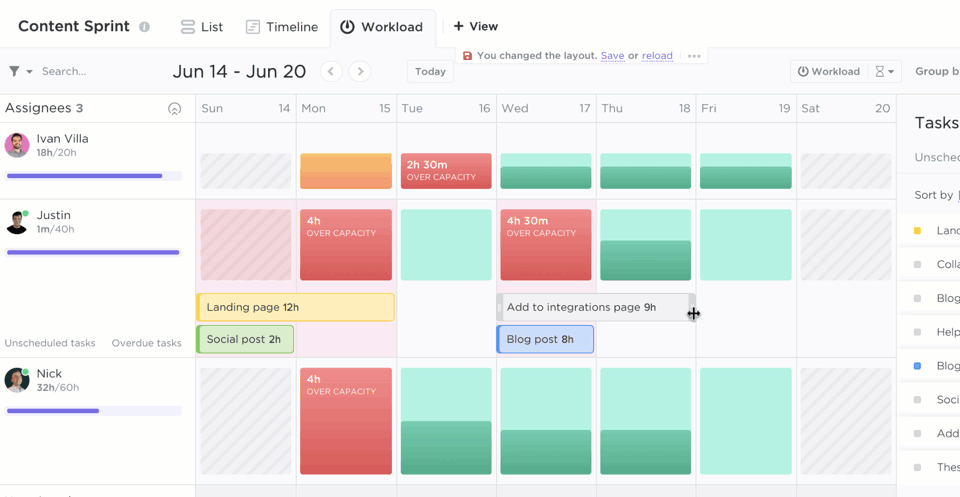
استخدم طريقة عرض عبء العمل في ClickUp لمعرفة من هو متقدم أو متأخر وسحب المهام وإفلاتها بسهولة لإعادة تخصيص الموارد
تأكد أيضًا من مراعاة ميزانية الحملة التسويقية المخصصة لعميلك حتى لا تفرط في الموارد.
مثال: ستقوم بتعيين ثلاثة مديرين للتسويق عبر وسائل التواصل الاجتماعي لهذا المشروع، سام وليديا وماركو. كل شخص لديه خبرة في إدارة الحملات على تويتر وإنستغرام وتيك توك، على التوالي. ستقوم بإنشاء أصول في Canva وFinal Cut Pro وجدولة المنشورات من خلال Hootsuite. تبلغ ميزانية هذه الحملة 15,000 دولار أمريكي.
5. قم بتخطيط مشروع حملتك على جدول زمني 📅
قم بإنشاء تقويم المحتوى لتوضيح المعالم الرئيسية وإدارة التوقعات بين وكالتك وعملائك. يمكنك أنت أو مدير حملتك التسويقية امتلاك تقويم المحتوى في جدول بيانات بسيط أو الأفضل من ذلك أن يكون تعاونيًا أدوات إدارة المشاريع مثل ClickUp.
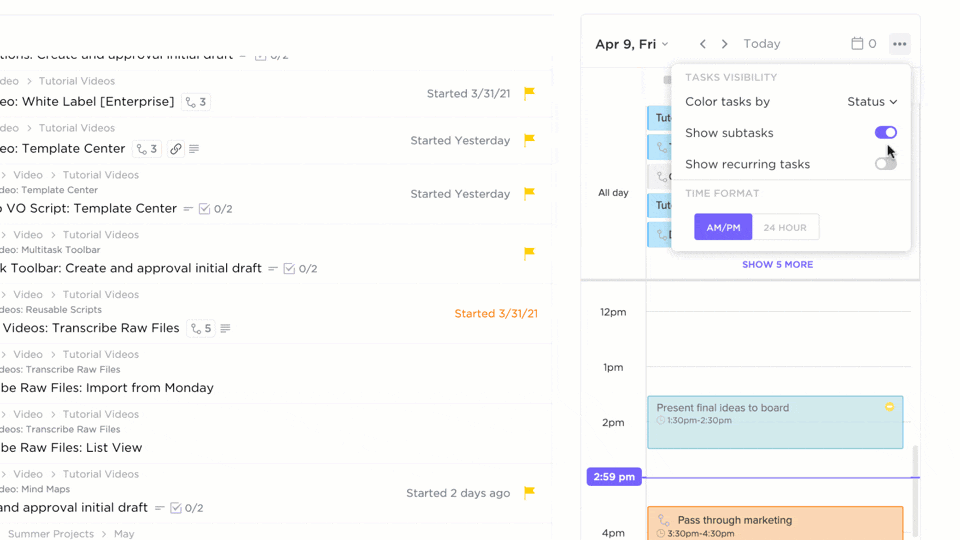
استخدم طريقة عرض تقويم ClickUp Home لإنشاء مهام، أو إضافة اجتماعات، أو مراقبة قائمة مهامك في نفس الوقت
مثال: تتألف حملتك لـ MySkinDoc من نسخة وأصول لوسائل التواصل الاجتماعي للتسويق على تويتر وتيك توك وإنستجرام:
- ستستمر حملات MySkinDoc على تويتر وتيك توك وإنستجرام من 1 أكتوبر حتى 31 ديسمبر
- ستقوم وكالتك بصياغة جميع التسليمات قبل أسبوعين على الأقل من تاريخ استحقاقها، وسيقوم فريق التسويق في MySkinDoc بتقديم الملاحظات أو الموافقات في غضون أسبوع بعد التسليم
- سيقوم فريقك بجدولة كل منشور على وسائل التواصل الاجتماعي في Sprout Social، باتباع أفضل الممارسات الخاصة بهم من أجلأفضل وقت للنشر على كل منصة
- ستقوم بتحديد المواعيد النهائية لكل عنصر من عناصر العمل في تقويم المحتوى وتعيينه إلى الطرف المسؤول، على سبيل المثال، سيقوم سام بصياغة نسخة تويتر بحلول 9 سبتمبر، وماركو لتصوير وتحرير تيك توك بحلول 14 سبتمبر، إلخ.
6. نفّذ خطتك 🏃
إن التخطيط لحملة تسويقية يشبه إعداد صاروخ للإطلاق: التأكد من وجود وقود كافٍ ورواد الفضاء المناسبين على متنه. إن تنفيذ حملتك هو الضغط على زر "الإقلاع" والتأكد من بقاء الصاروخ في مساره الصحيح، والانطلاق نحو القمر!
وللحفاظ على الزخم في هذه المرحلة، تحقق من أعضاء الفريق للتأكد من أنهم ينجزون التسليمات في الوقت المحدد. شجّع الجميع على الالتزام بالخطة الموضوعة ولكن كن مستعدًا لمواجهة أي مفاجآت غير متوقعة، مثل تغيير العملاء لنطاق المشروع في منتصف الطريق. وإلا فإن صاروخ حملتك قد ينهار فجأة!
حوّل التعليقات إلى مهام ClickUp أو قم بتعيينها لتحويل الأفكار إلى عناصر عمل على الفور
تواصل بانتظام مع عميلك للتأكد من أن جميع أصحاب المصلحة بما في ذلك مدير حملتك التسويقية - بما في ذلك مدير حملتك التسويقية - متوافقين بشأن التوقعات وأي تأثيرات على المواعيد النهائية. لا تقم بتعديل الجدول الزمني لحملتك والتسليمات إلا عند الضرورة القصوى. تذكر أن التأخير يجعل من الصعب الحفاظ على الحملات في حدود الميزانية وغالبًا ما يؤدي إلى زحف النطاق .
مثال: يقوم فريقك بعمل رائع. لقد التزموا بكل المواعيد النهائية، وقد وافق MySkinDoc على جميع مسوداتك دون أي ملاحظات. لكن سام تعرض لحادث تزلج خلال عطلة نهاية الأسبوع وسيكون الآن خارج المكتب لبقية حملتك التسويقية.
سيتعين عليك العثور على عضو جديد في الفريق يمكنه تولي إدارة حملة تويتر. لحسن الحظ، بو متاح للمساعدة في مختلف منصات التواصل الاجتماعي. وبما أنه جديد على الحساب، فإن منشوراته القليلة الأولى لا تفي بالغرض في مخاطبة الجمهور المستهدف لـ MySkinDoc. يقدم العميل ملاحظاته، وتتسبب المراجعات اللاحقة وعملية الموافقة النهائية في تأخير جدول النشر على تويتر.
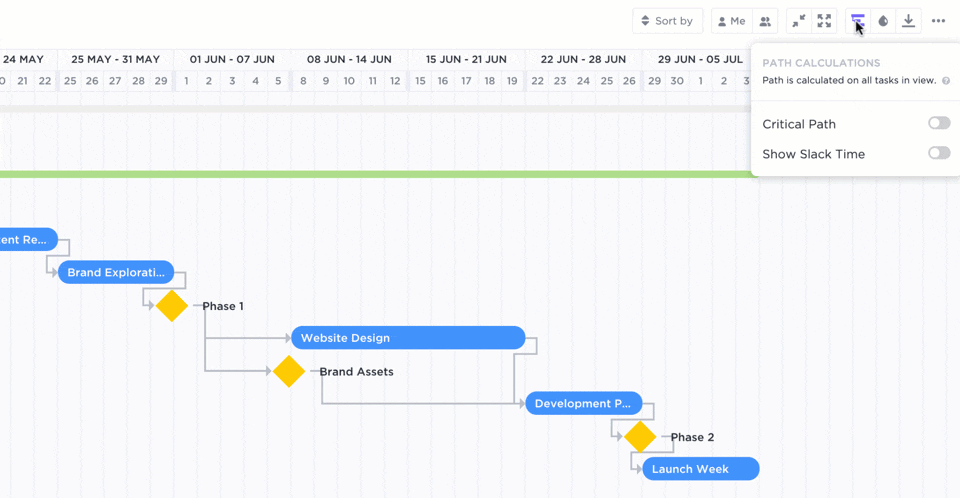
اعرض عبء العمل الخاص بك حسب المهام المتبقية في المسار الحرج بتبديل واحد في ClickUp!
هناك بعض الطرق التي يمكنك من خلالها استباق كل هذه الاضطرابات غير المتوقعة. أولاً، أخبر عميلك على الفور عن حالة سام.
اطلب منهم الصبر بينما يتعلم بو الحبال. اضبط جدولك الزمني وتقويم المحتوى الخاص بك ليعكس الوقت الذي يحتاجه ليعمل بشكل صحيح على الحساب. أخيرًا، اطلب من ليديا وماركو تقديم يد العون لبو حتى يتمكن من فهم احتياجات MySkinDoc بشكل أفضل في أسرع وقت ممكن.
7. راقب مؤشرات الأداء الرئيسية 📈
استخدم مؤشرات الأداء الرئيسية التي حددتها بالفعل في الخطوة 3 لتقييم أداء الحملة.
إذا لم يكن أداء حملتك جيدًا كما هو متوقع، فعليك رفع هذه الأرقام!
قم بتبادل الأفكار داخليًا حول كيفية تعزيز مقاييسك. ربما احتاج إعلان إنستاجرام إلى صورة أكثر ألوانًا، أو ربما احتاج التعليق إلى اختصاره. أبقِ عملاءك على اطلاع على عملية إدارة الحملة واحصل على موافقتهم على أي تحولات في استراتيجية التسويق أو المواعيد النهائية.

العصف الذهني للأفكار ورسم شكل حر خريطة ذهنية في الوضع الفارغ في ClickUp
مثال: في بداية حملتك، كان حساب MySkinDoc على تويتر الخاص بـ MySkinDoc يضم 30 متابعًا فقط. كان الهدف هو مضاعفة عدد المتابعين كل شهر. شهد شهر أكتوبر اكتساب الحساب 40 متابعًا، متجاوزًا هدفك، لكن الحساب اكتسب 50 متابعًا فقط في شهر نوفمبر. بالنسبة لشهر ديسمبر، كيف يمكنك التأكد من الانتقال من 120 إلى 240 متابعًا؟
الهبات طريقة رائعة لتعزيز المشاركة على تويتر. يمكنك أن تسأل MySkinDoc عما إذا كان بإمكانهم إجراء هبة ترويجية ترويجية، وإهداء استشارة مجانية مع أحد أطباء الجلدية على منصتهم إلى أحد المتابعين المحظوظين على تويتر. يوافق العميل، ويبدأ بو في العمل على الترويج لهذه الهبة على تويتر.
وسرعان ما يكتسب حساب تويتر متابعين مهتمين بهذه الاستشارة المجانية. وحتى إذا ألغوا متابعتهم بعد انتهاء الحملة، فقد ضمنت أنك حققت مؤشرات الأداء الرئيسية الخاصة بك وأنك ستصل إلى الأشخاص مباشرةً في الجمهور المستهدف من MySkinDoc لبقية شهر ديسمبر.
فوائد إدارة الحملات التسويقية بشكل جيد حقًا
أي وكالة تسويق يمكن للقائد أن يخبرك أن الحملة تحتوي على الكثير من الأجزاء المتحركة. لديك أشخاص يعملون في مختلف الأقسام لإنشاء المنجزات . وهناك العديد من المواعيد النهائية التي يجب تتبعها مع إبقاء العملاء على اطلاع دائم بالتقدم المحرز. دعنا نقول أن القائمة تطول.
ولكن الهدف هو جعل كل هذه الأجزاء المتحركة أكثر قابلية للتنبؤ. مع إدارة حملات التسويق، يمكن لأعضاء فريق وكالتك أن يتنفسوا لأنهم يعلمون:
- ما هي مسؤولياتهم
- متى يحين موعد تسليمهم للنتائج
- أين يجدون ملاحظات العملاء
تقوم إدارة الحملات التسويقية بإعداد أعضاء فريق وكالتك لـ تقديم الحملة في الوقت المحدد وتحقيق أهداف العميل، مع وضع وكالتك كشريك استراتيجي وليس مجرد بائع آخر.

أنشئ أهدافًا عالية المستوى باستخدام الأهداف في ClickUp، ثم قسّمها إلى أهداف أصغر لتتبع تقدمك
يرغب العملاء في الحصول على مخرجات حملات تسويقية عالية الجودة تصل في الوقت المحدد وتحقق نتائج ملموسة. وبينما لا تضمن الإدارة الفعّالة للحملات التسويقية تلك النتائج، إلا أنها تجعلها أكثر قابلية للتحقيق.
قد تبدو الإدارة الفعالة للحملات التسويقية في وكالتك على النحو التالي:
- يتحقق قادة الحسابات من تقدم المشروع للتأكد من التزام أعضاء فريق الوكالة بالمواعيد النهائية. وفي الوقت نفسه، ينقلون ملاحظات العميل إلى أعضاء الفريق للتأكد من أن المخرجات عالية الجودة.
- يعرف جميع أعضاء فريقك بشكل فردي المهام الموكلة إليهم وتواريخ استحقاقها، مما يسهل عليهم إنجاز جميع مهامهم في الوقت المناسب.
- يعرف عملاؤك ما يمكن أن يتوقعوه منك، ويعرفون بدورهم ما هو متوقع منهم، أي تقديم الملاحظات في مواعيد محددة.
تحصل حملات التسويق الفعالة ببساطة على النتائج التي يريدها عملاؤك، مما يجعلهم سعداء. والعملاء الراضون من المرجح أن يكونوا شركاء متكررين. أنت تريد نجاحًا موازيًا حتى ينشروا الكلمة عن قدرة وكالتك على إنجاز الأمور بسرعة ونجاح.
الحملة التسويقية الجيدة تبني العلامة التجارية لعميلك وإيراداته، ولكن الحملة التسويقية المدارة بشكل جيد تبني وكالتك
على الجانب الآخر، يمكن أن تؤدي الحملات التسويقية سيئة الإدارة إلى نتائج كارثية لكل من عملائك والعلامة التجارية لوكالتك. انظر تغريدة برجر كينج بمناسبة اليوم العالمي للمرأة أو تلك التغريدة إعلان كيندال جينر بيبسي ...بالتأكيد ليس هذا النوع من الحملات التسويقية التي تريد أن يربطها العملاء المحتملين بوكالتك!
قوالب إدارة الحملات التسويقية
من منا لا يحب القوالب الجيدة؟ نحن بالتأكيد نحبها. فهي تجعل الحياة أسهل بكثير لأنك لست مضطرًا لتصميم نظام أو مستند كامل من الصفر.
سواء كنت تقوم بالتسويق لعلامة تجارية واحدة أو 12 علامة، تحقق من ستة من النماذج المفضلة لدينا (المجانية!) القوالب التي يمكن أن تساعدك إدارة جميع مشاريعك التسويقية .
1. قالب إدارة حملة ClickUp الترويجية والحملات الترويجية
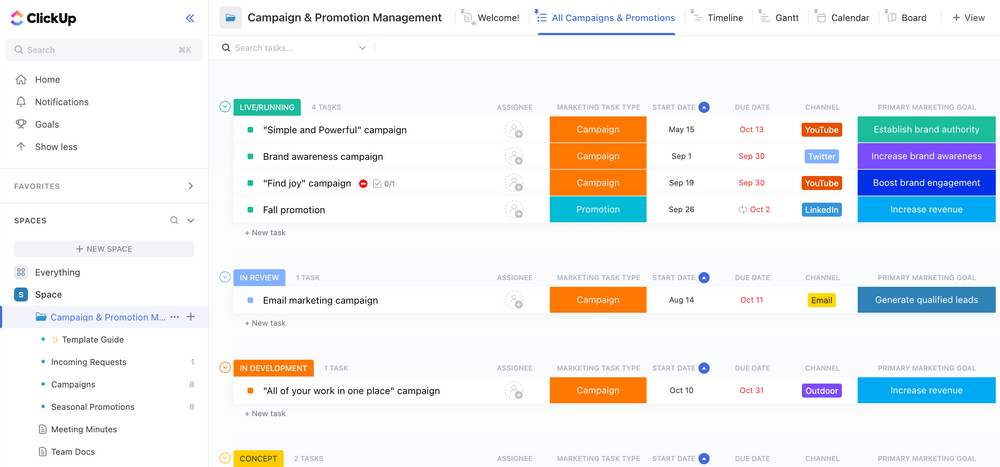
يوفر هذا النموذج سير عمل شامل، بدءًا من تلقي الطلبات وحتى تخطيط الحملة وتنفيذها
و قالب إدارة حملة ClickUp وإدارة الترويج هو مورد متكامل لأي مدير حملة تسويقية أو أصحاب المصلحة في فرق التسويق.
يأتي هذا القالب مع العديد من انقر فوق طرق العرض لمساعدتك على تصور وتخطيط حملاتك التسويقية من زوايا مختلفة:
- حملة إطلاق المنتج: في لمحة سريعة وقائمة مرجعية عالية المستوى لجميع المهام، مجمعة حسب مرحلة الحملة
- متتبع فريق وسائل التواصل الاجتماعي: يقسّم مهام وسائل التواصل الاجتماعي إلى عناصر عمل، مرتبة حسب الفريق المسؤول. يحدد نوع المحتوى الذي سيتم تقديمه وقنوات التواصل الاجتماعي ذات الصلة
- مرحلة التسويق: يفصل المهام حسب المرحلة في لوحة كانبان
- التقويم: يخطط كل ما يتعلق بـمهام التسويق في تقويم لسهولة رؤية ما هو مستحق بعد ذلك
- المراجع: لتخزين ما تحتاج إلى معرفتهموارد التسويقمثل عرضك التسويقيإرشادات العلامة التجاريةومعلومات المنتج، فيمستندات ClickUp
- متتبع الميزانية: يعرض الميزانية المخصصة لكل مهمة، بحيث تبقى دائمًا في حدود الميزانية إضافة قالب ### 2. قالب عرض قائمة إدارة حملة ClickUp وإدارة العروض الترويجية
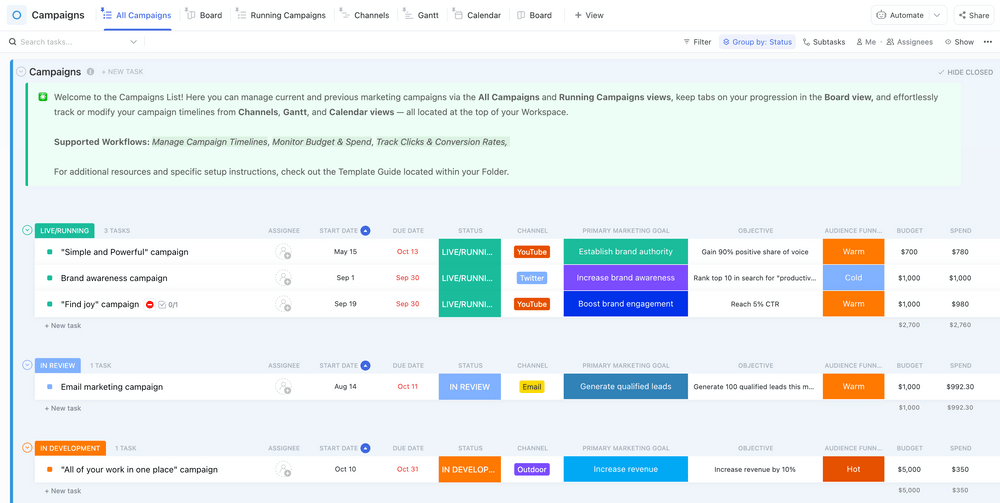
استخدم طريقة عرض القائمة في قالب إدارة الحملات والعروض الترويجية في ClickUp لتتبع الميزانيات وغيرها من تحليلات التسويق المهمة .
باستخدام نفس قالب إدارة حملة ClickUp والحملة الترويجية، يمكنك تعديل طريقة عرض القائمة لتوضيح الجوانب المهمة لحملتك مثل الأهداف والجمهور المستهدف والميزانية والإنفاق وحالة المشروع.
لا مزيد من المضايقات لفرق التسويق للحصول على التحديثات أو البحث بعمق عن مؤشرات الأداء الرئيسية. يساعدك قالب تتبع الحملة هذا على:
- الاطلاع على جميع حملاتك ومقاييس التحويل الخاصة بها في وقت واحد، واختيار مؤشرات الأداء الرئيسية المحددة التي تريد تتبعها باستخدام حقول بيانات قابلة للتخصيص
- تصور سير عمل حملتك في طرق عرض متعددة (يستخدم هذا المثال طريقة عرض القائمة)
- الالتزام بالجدول الزمني وإدارة المواعيد النهائية باستخدام حقول تاريخ البدء وتاريخ الاستحقاق القابلة للتخصيص إضافة قالب ### 3. قالب عرض كانبان لإدارة الحملات الترويجية وحملة ClickUp
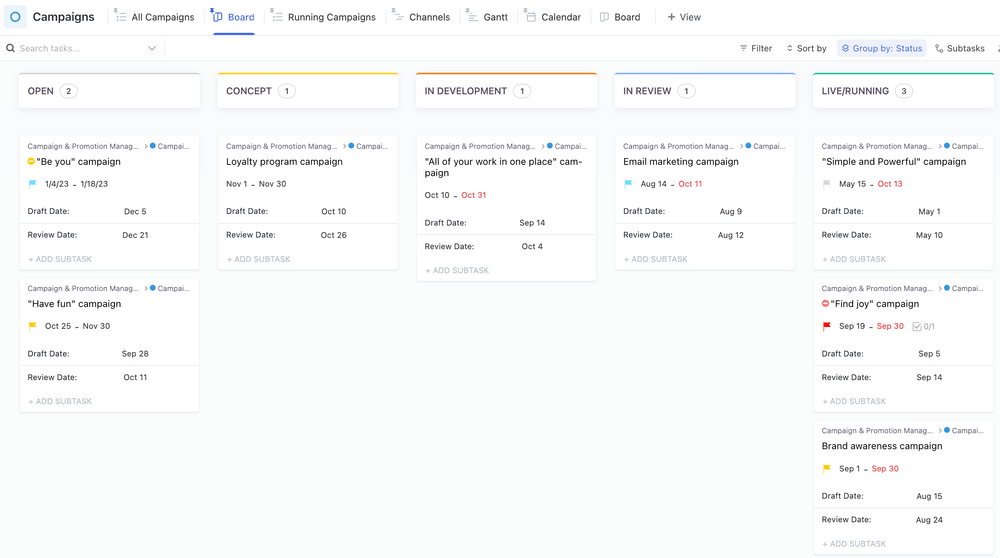
استخدم طريقة عرض كانبان هذه في قالب إدارة الحملات والترويج لتنظيم حملاتك بكفاءة
مرة أخرى، في نفس قالب إدارة الحملات والترويج في ClickUp، يمكنك استخدام طريقة عرض كانبان كقالب جديد تمامًا لتتبع حملاتك وإدارتها.
تُعد طريقة العرض هذه مثالية لإدارة حملات وسائل التواصل الاجتماعي لأنك تمنح أصحاب المصلحة وغيرهم من مراقبي المشروع نظرة شاملة على حالة كل أصل أو منشور أو جزء من المحتوى للحملة الاجتماعية. إضافة قالب
4. قالب موجز حملة ClickUp
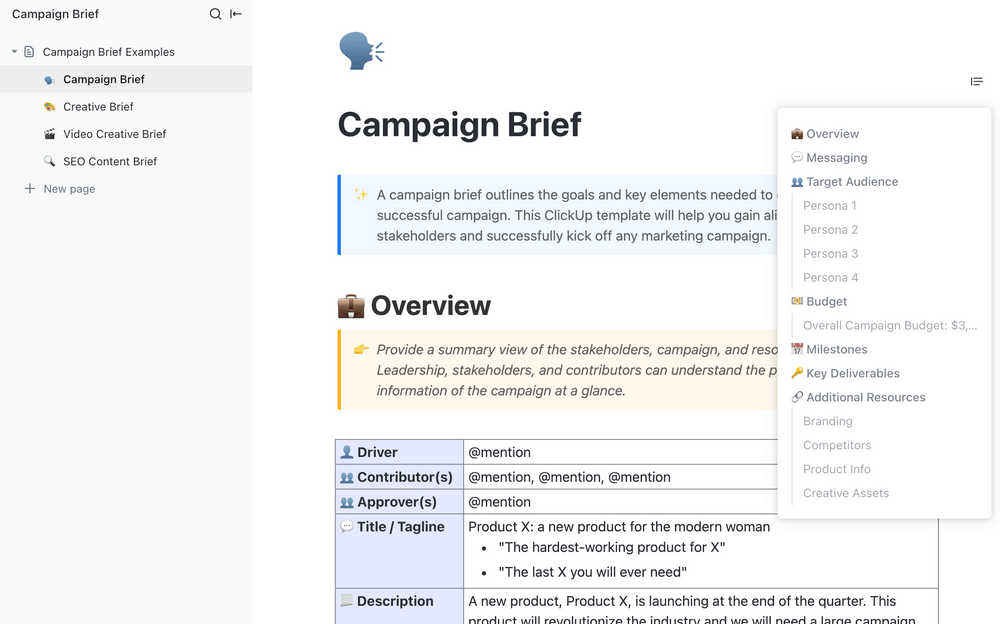
قم ببناء كل خطوة من خطوات سير عمل حملتك في هذا الموجز النموذجي في مستندات ClickUp
هل تحتاج إلى تلخيص حملاتك بإيجاز، خاصة للحصول على موافقة العميل؟
احرص على أن تكون أنت وعملاؤك على نفس الصفحة مع نموذج موجز حملة ClickUp للحملة الذي يساعدك على تحديد الأهداف وصياغة مقترح لأي حملة تسويقية في مستند موجز بسيط.
يرشدك هذا القالب إلى تحديد مكونات الحملة التسويقية الأساسية التالية واحداً تلو الآخر:
- نظرة عامة على الحملة
- السوق المستهدفة (بما في ذلكقوالب شخصية المستخدم)
- الميزانية المقترحة
- التواريخ الهامة
- الجهود التسويقية والمواد التسويقية (أي الأصول أو النواتج)
- المراجع (روابط لموارد التسويق ذات الصلة، مثل إرشادات العلامة التجارية، وقائمة المنافسين، وبيانات اعتماد تسجيل الدخول، وما إلى ذلك)
- الملخص والموافقة إضافة قالب ### 5. قالب مستند موجز إبداعي من ClickUp
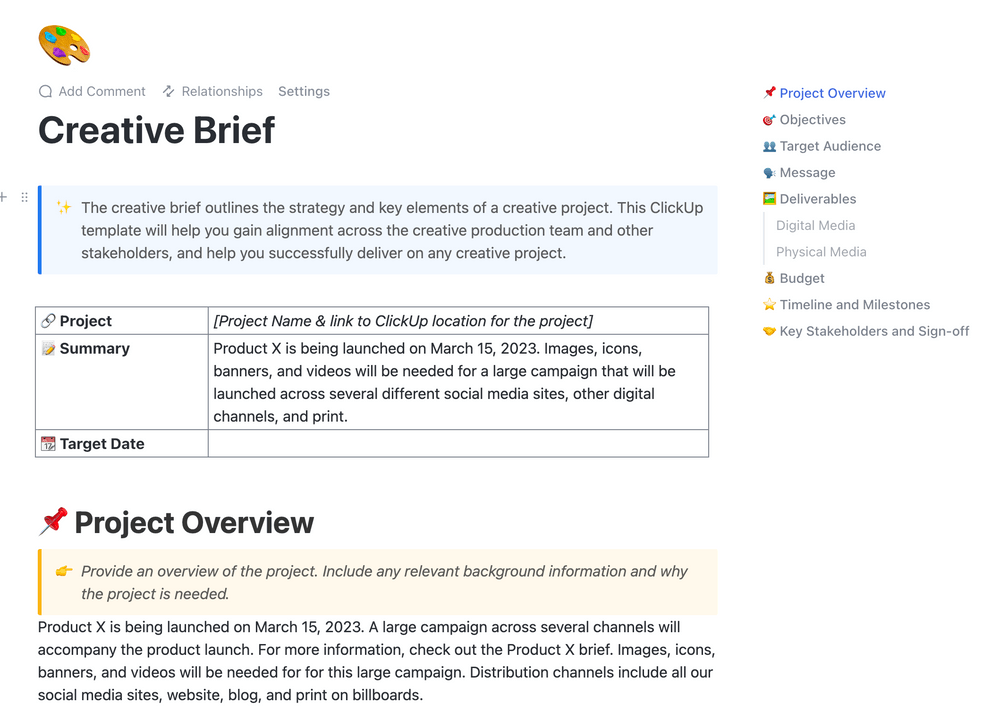
يعمل هذا القالب على مواءمة فرق الإنتاج وأصحاب المصلحة لتقديم مشاريع إبداعية من خلال تحديد الاستراتيجية العامة والعناصر الرئيسية نموذج الموجز الإبداعي الخاص ب ClickUp نظرة عامة موجزة ومختصرة لما تدور حوله حملتك. مثالي لمساعدتك أنت وعميلك على التوافق على التفاصيل الأساسية والجداول الزمنية. هذا أمر لا بد منه لفرق التسويق.
إليك ما يتضمنه:
- نظرة عامة على الحملة: حدد أهداف حملتك ومراحلها الرئيسية وميزانيتها والجمهور المستهدف
- ملخصات إبداعية : شرح كيفية تحديد رسائل حملتك، والدعوات إلى اتخاذ إجراء، والمخرجات
- موجزات الفيديو: تخطيط إنتاج الفيديو الخاص بك مع لوحة العمل وقائمة اللقطات وجدول التصوير
تحقق من هذه
_/مرجع/ https://clickup.com/blog/creative-brief-examples// أمثلة موجزة مبتكرة *%/href/_
للإلهام إضافة قالب
6. قالب تقويم حملة ClickUp

تأكد من بقاء فريقك منظمًا مع حملاتك المختلفة في مساحة واحدة قابلة للمشاركة
قالب قالب تقويم حملة ClickUp يساعد فريقك على البقاء منظمًا أثناء إدارة جميع حملاته التسويقية. يمنحك هذا التقويم الصورة الكبيرة لجميع حملاتك النشطة من خلال تخطيطها على الخريطة، مما يتيح لك التخطيط الاستراتيجي والسماح لك بـ
- تخطيط حملاتك على تقويم للأحداث، يمكن عرضه حسب اليوم أو 4 أيام أو الأسبوع أو الشهر
- عرض حملاتك جنبًا إلى جنب في جدول زمني لفهم كيفية تداخل حملاتك مع بعضها البعض السحب والإفلات لضبط تواريخ بدء الحملة وانتهائها أو مدتها
- عرض عناصر الإجراءات التي تحتاج إلى اهتمامك الفوري عبر الشريط الجانبي الأيمن، والذي يسرد جميع المهام غير المجدولة والمتأخرة
- قم بإدراج جميع حملاتك وقم بتجميعها حسب المدة للتمييز بين حملاتك لمرة واحدة أو قصيرة الأجل أو طويلة الأجل
- اطلع على الحالات الحالية لجميع حملاتك حتى يتمكن مديرو حملاتك التسويقية من ضبط التقدم المحرز من خلال السحب بين الأعمدة على لوحة كانبان المرئية إضافة قالب ## تحسين عملية إدارة حملاتك التسويقية باستخدام ClickUp
لا يمكن أن تكون كل حملة تسويقية "سهلة ومنسّمة وجميلة" مثل Covergirl، ولكن يمكننا أن نجعلك تقترب خطوة واحدة من ذلك. 😉
ClickUp هو برنامج شامل أداة لإدارة الحملات تساعد الوكالات وفرق التسويق على تبسيط كيفية التعاون مع العملاء في الحملات التسويقية من البداية إلى النهاية.
فيما يلي بعض الطرق التي تساعدك بها أداة ClickUp على قضاء وقت أقل في التنظيم و وقت أكثر في العمل:
- تخزين المعلومات التي يحتاج عملاؤك إلى معرفتها,تقويمات المحتوىوإرشادات العلامة التجارية في مستندات تعاونية مخصصة
- تصوّر المدة التي ستستغرقها حملتك بالضبط وارسم الروابط بين المهام باستخداممخططات جانت الخاصة بـ ClickUp
- حافظ على التزام الحملات بالجدول الزمني من خلال مراقبة مؤشرات الأداء الرئيسية علىلوحات معلومات ClickUp وتتبع تقدم فريقك تلقائيًا نحو تحقيق أهداف قابلة للقياس اشترك في ClickUp مجاناً لبدء إدارة حملات تسويقية أكثر فعالية اليوم.

